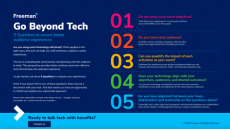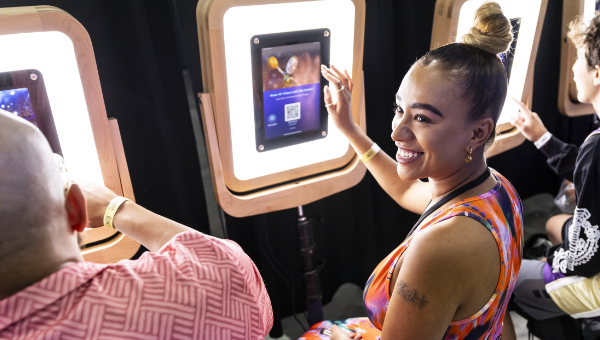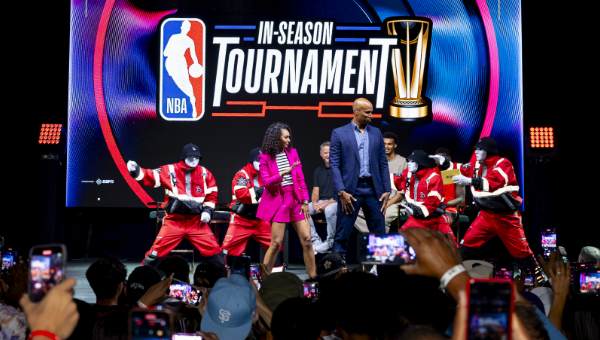Best Practices
Experiential Tech for the Sake of It
Balancing innovation with intention for a better attendee experience



Loading Form
What You’ll Learn
- Technology can often hinder rather than enhance the attendee journey — why?
- What it takes to create truly audience-centric experiences.
- How to quantify the impact of adding tech to activations before implementation.
- Evaluate your current experiential tech approach with our 5-question quiz!
In the constant race to create “future-forward” event experiences, incorporating AI, AR, VR, and other emerging technologies can be an assumed expectation. However, the effectiveness and overall value of these integrations varies greatly, often leaving attendees feeling disconnected or underwhelmed, while event marketers struggle to measure success.
It’s essential to strike a balance between innovation and intentionality when it comes to events. How do we move beyond tech-enabled experiences and focus on creating truly enhanced journeys that deliver value to both the brand and its audience?
The disconnect: tech + user experience
It’s not uncommon for technology to hinder rather than enhance experiences. For instance, how often do you yearn for the days when you could just put your eggs on the conveyor belt at the grocery checkout, without the added task of juggling bags and keying in your own purchase?
Oftentimes, it’s not the technology itself that’s flawed or unhelpful — it’s the lack of end-user consideration or disconnect with the existing environment.
Consider my recent experience going through customs at Global Entry when interacting with a digital kiosk created heaps of confusion and frustration. The passport scanner indicated one action, the attendant instructed another, which led to chaos amongst the (admittedly groggy) crowd. Not to mention a longer wait than the traditional, human-enabled queue.
This scenario highlights a common issue for event professionals and experience designers:
Technology exists to solve a problem. But those who apply it for engagement in an event setting don’t always consider external factors or the end-user experience.
And that misstep often complicates the experience and frustrates the attendee altogether.
To create truly impactful experiences, we need to shift our focus from building technology-first solutions to designing audience-centric experiences. Sounds easy enough — but with the accelerating pace of digital transformation, there is an additional layer of nuance and complexity (i.e. budget, resources, accessibility considerations, executive buy-in) when making these decisions.
The audience-centric approach
To dive into creating a more audience-focused experience, let’s take the hypothetical example of planning a C-Level event. To achieve our objective of showing executives a new facility, we’ve got two options:
- Provide 50 Apple Vision Pro headsets for an immersive virtual tour.
- Flying attendees to the location (assuming cost is the same for both options).
From a planning perspective, it often makes sense to jump immediately to an effort/impact matrix, specifically evaluating solutions from the event marketer’s lens, i.e. how much effort or cost will this take to implement, and what potential outcomes will arise that deliver on company objectives.
While this is vastly important, flipping the script, putting on your Event Experience Strategist cap, and placing the audience at the forefront allows planners to prioritize the overall experience and develop solutions that holistically enhance the event.
By considering factors such as novelty, credibility, accessibility, and sustainability, this example outlines the imperative of structured, audience-centric, and case-by-case decision-making to truly balance technological innovations with the experiential benefits they provide to unique audiences.
Let’s dig a little deeper into this hypothetical event with two different company types:
Brand A: Manufacturing company with an eye on sustainability
- Common challenge is capturing the attention of its elusive C-level audience.
- Adopting an immersive, virtual reality approach maximizes (virtual) attention on the new facility while also delivering on emissions commitments.
Brand B: High-end fashion house focused on influencer marketing
- The physical and tactile experience of interacting with the products and the facility holds greater appeal and authenticity.
- This group also has the flexibility to travel, so the concern for accessibility takes a back seat to the novelty and credibility offered by the physical experience.
Both experiences hold tremendous value, but they cater to different audience types and serve distinct brand objectives.
Evaluating the impact: ROI and ROO
When planning experiences in this tech-forward era, it’s crucial to evaluate the short and long-term impact to better inform future decisions.
Traditional metrics like ROI and sentiment surveys often fall short in capturing the true impact technology has on outcomes, customer sentiment, and the value the experience delivers.
But with so much urgency and pressure to avoid being left behind in the race toward progress, we need a way to quantify the impact of adding tech quickly and accurately before implementation. The answer? Develop a better framework. How? (More on that below!)
In the meantime, consider a matrix that quantifies the impact of different activations. By aligning the technology with the client’s objectives and goals, we can make informed decisions about the most valuable options.
Returning to the fundamental concept of Return on Objective (ROO) reframes the conversation and guides our clients toward selecting the right technology that aligns with desired outcomes. This approach helps avoid the pitfall of selecting technology merely for the sake of it and ensures that the solution is tailored to the specific context.
Striking the balance: constant scrutiny and scalable solutions
As technology becomes increasingly ubiquitous, it’s crucial to relentlessly scrutinize its value and impact on event experiences and for the audiences themselves. And this works best while adhering to a decision-making framework that allows these solutions to be scaled, for decisions to be made efficiently, and, conversely, to identify tech enhancements based on desired outcomes.
We could once rely on the “wow factor” to compensate for hiccups in the actual experience, but technology is progressing quickly, and today’s event landscape now demands a more thoughtful approach.
Technology presents exciting opportunities, but it should not be treated as a one-size-fits-all solution.
A smarter approach is to start with an evaluation of current practices. Then develop and implement a framework of objectives, audience, and context to determine the optimal integration.
Striking the right balance between innovation and intentionality not only enhances journeys that leave a lasting impression on attendees but also helps establish your brand as a strategic, forward-thinking leader.
Ready to create more effective experiential activations?
Click the pink button to test your tech with this quiz.
Baylee Newsom, Senior Strategist for Freeman, approaches strategy with a profound curiosity for client audiences, objectives, and challenges. As a natural storyteller, she revels in unearthing insights crucial for crafting meaningful experiences. Prior to Freeman, Baylee was the social media lead at Forbes and spearheaded content and community strategy at a blockchain-based tech startup.
Let's get started
Reach out and request a consultation.
Reach out and request a consultation.



